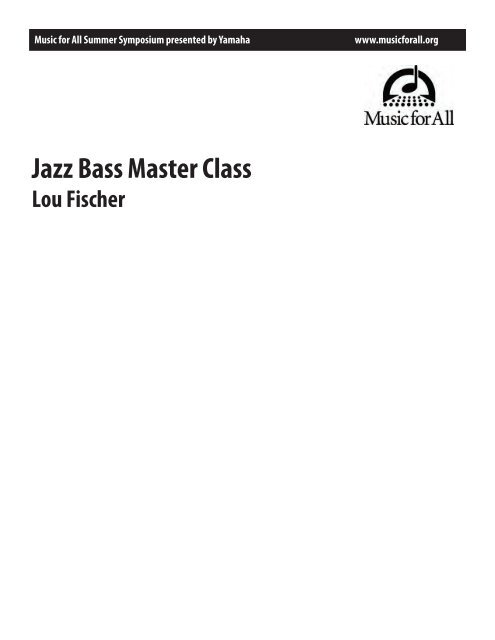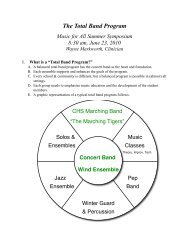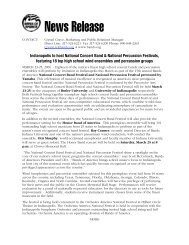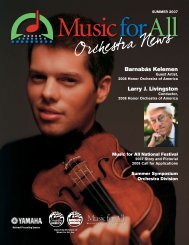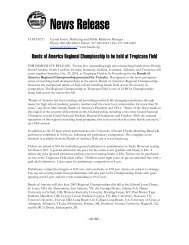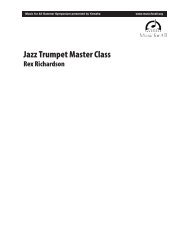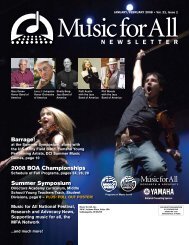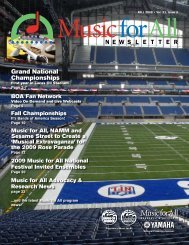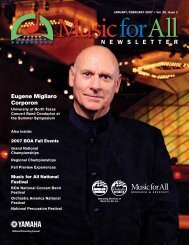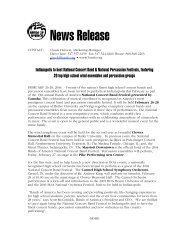Jazz Bass Master Class - Music for All
Jazz Bass Master Class - Music for All
Jazz Bass Master Class - Music for All
Create successful ePaper yourself
Turn your PDF publications into a flip-book with our unique Google optimized e-Paper software.
<strong>Music</strong> <strong>for</strong> <strong>All</strong> Summer Symposium presented by Yamahawww.music<strong>for</strong>all.org<strong>Jazz</strong> <strong>Bass</strong> <strong>Master</strong> <strong>Class</strong>Lou Fischer
<strong>Bass</strong>? cwThree Finger Patterns- G StringFingerings:0 1 2 1 2 4 1 2 4# w w bww bww bww? bw1 w 2 4 1 2 4 1 2 4w w w # w w # w w? # w1 2 4 1 2 4 1 2 4w bww bww bww w? w 1 2 4 1 2 4 1 2 3w # w w # w w # w w bw?1 2w3 3 2 1 3 2 1# w w w bww bww bw? w 3 bw2 1 4 2w bww14 2w w 1w bw? w bww bww bww bw4 2 1 4 2 1 4 2 1w4 2 1 4 2 1 4 2 1? bww w w w bww bww? bww bww bw4 2 1 4 2 1w© 2009 Dr. Lou Fischer
<strong>Bass</strong>? 43œ œ # œ œ bœ?œ # œ œ bœnœœ bœnœœ bœnœœ bœnœœ bœ?# œ œ # œ œ œ # œ œ œ # œ œ bœ? œ # œ œ œ # œ œ œ # œ œ bœ? bœnœ? œ bœ? bœbœbœnœnœœ bœnœœ bœbœbœnœnœnœnœbœnœbœœ œ bœnœœ # œ œ œ # œ œnœœ bœ? œ œ # œ œ œ # œ œ bœ? œ # œ œ œ # œ œ bœ? bœnœThree Finger Patterns - Cross StringsString: E------------------ A-------------------- D------------------- G------------------String: E------------------ A--------------------- D------------------- G--------------------bœbœnœnœbœbœnœnœœ bœnœœ bœnœœbœnœbœœ œ # œ œ œ # œ? œ # œ œ œ # œ œ œ # œ œ œ # œ œœ© 2009 Dr. Lou FischerDon't Forget to Come Down!
2 Three Finger Patterns Cross Strings? ∑ ∑ ∑ ∑ ∑ ∑ ∑ ∑? ∑ ∑ ∑ ∑ ∑ ∑ ∑ ∑? ∑ ∑ ∑ ∑ ∑ ∑ ∑ ∑? ∑ ∑ ∑ ∑ ∑ ∑ ∑
<strong>Bass</strong>q»¤¢º? c œ # œ œ bœFour Finger Patterns - Cross Stringsbœnœbœnœœ bœnœœ? bœnœœ # œ œ œ # œ œ œ # œ œ # œ? bœnœbœnœœ bœnœœ bœnœœ # œ? œ œ # œ œ œ # œ œ bœ# œ œ bœnœ?œbœœ bœbœœ bœœ œ bœœ œ?bœœ œ bœœ œ bœœ œ bœœ bœ? bœœ bœœ œ bœœ œ bœœ œ bœ? œ œ bœœ œ bœœ bœbœœ bœœ© 2009 Dr. Lou Fischer
<strong>Bass</strong>? b b cq»¡¤ºB b 7œ œ œ œExample #1: Play The ROOT!E b 7œ œ œ œB b 7œ œ œ œœ œ œ œ? b bE b 7œ œ œ œB b 7œ œ œ œ œ œ œ œœ œ œ œ5? b bF 7œ œ œ œE b 7œ œ œ œB b 7œ œ œ œF 13œ œ œ œ9Example #2: ROOT w/Lower LEADING Tones131721? b b? b b? b bB b 13œ œ œ œE b 13œ œ œ œF 13œ œ œ œE b 13œ œ œœ œ œE b 13œ œ œœB b 13œ œ œ œB b 13œ œ œ œ œœB b 13œ œ œ nœœ œ œ œœ œ œ nœF7(alt)œ œ œœ© 2009 Dr. Lou Fischer
? b b252933? b b? b bExample #3: ROOT w/Upper LEADING TonesB b 13œ œ œ nœE b 13œ œ œ nœF 13œ œ œ nœE b 13œ œ œ nœB b 13œ œ œ nœB b 13œ œ œ nœœ œ œ nœE b 13œ œ œ nœB b 13œ œ œbœœ œ œ nœœ œ œF 13œ œ œbœnœ2Example #4: ROOT w/a Combination ofLower & Upper LEADING Tones37? b b? b bB b 13œ œ œ œE b 13œ œ œ œE b 13œœnœnœbœbœœB b 13œ œ œ nœB b 7( # 9)nœœ œ œœœ œ œ nœœ œ œ bœ4145? b bF 13œbœœ nœE b 13œnœbœœB b 13œ œ œ nœF7(alt)œnœœnœ
Example #5: ROOT w/Lower AUXILIARY Tones3? b b49B b 13œ œ bœnœE b 13œœbœnœB b 13œ œ bœnœœ œ bœnœ53? b bE b 13œ œ bœnœœœbœB b 13nœœ œ bœnœœ œ œ nœ57? b bF 13œ œ bœnœE b 13œœbœnœB b 13œ œ œ nœF 13œœbœnœExercise #6: ROOT w/Upper AUXILIARY Tones? b bB b 13œ œ œœE b 13œ œ œ nœB b 13œ œ œ nœœœ œ nœ61? b bE b 13œ œ œ nœœœœB b 13nœœ œœnœœœ œ bœ65? b bF7(alt)œ œ œ nœE b 13œ œ œ nœB b 13œœœbœF 9œ œ œ nœ69
Example #7:ROOT w/a Combination ofLower & Upper AUXILIARY Tones4? b b73B b 13œ œ œ œE b 13œ œ œœB b 13œ œ bœnœœ œ bœnœ? b bE b 13œ œ nœœB b 13œ œ œ œ œœbœnœœ œ œ nœ7781? b bF 13œ œ œ œE b 13œbœœ nœB b 13œ œ œ nœF 13œ œ œœExample #8: ROOT w/Lower LEADING LINE85? b bB b 13œ œ bœnœE b 13œœbœnœB b 13œœbœnœœœbœnœ8993? b b? b bE b 13œ œ bœF 13œ œ bœnœnœœE b 13œbœœ œ bœB b 13nœœ œ bœnœB b 7( # 9)œnœœ œ nœœ œ œ nœF 13œœbœnœ
Example #9: ROOT w/Upper LEADING LINE5? b bB b 13œbœœ nœE b 13œbœœ nœB b 13œbœœ nœœbœœ nœ97? b bE b 13œbœœ nœœbœœ nœB b 13œbœœ nœœbœœ bœ101? b bF 13œbœœ nœE b 13œbœœ nœB b 13bœœ bœœF 13œbœœ nœ105Example #10: ROOT w/a Combination ofLower & Upper LEADING LINE? b b109? b b113B b 13œE b 7( # 9)œbœœ nœœbœnœE b 13œœœœbœbœnœB b 13œ œ bœB b 13œ œ œ bœnœnœœ œ bœnœœ œ œ bœ? b b117F 13œnœœ œE b 13œœbœnœB b 13bœœ bœœF 13œ œ bœ.bœnœ
6Example #11: Mixing It <strong>All</strong> Together? b bB b 13œ œ œ nœE b 13œbœœ nœB b 7( # 9)œ.œ œbœnœœœ œ nœ.œ121? b b125E b 13œ œ œ nœœœbœB b 13nœœ nœbœnœœ œ œ nœ? b b129F 13œbœœ nœE b 13œ bœ.œ œ nœB b 13bœœ bœœF7(alt)œœ œ nœ? b b133Example #12: ROOT & FIFTHS w/Leading TonesB b 7( # 9)œnœœ œE b 13œnœbœœB b 13(sus)œnœœ nœB b 13 B b 7( # 9)œbœœ nœ? b b137E b 13œ œ œœœB b 13œ œ nœœ bœœ nœœ œ œ.œ nœ? b b141F 13œnœœ œE b 13œ œ œB b 13bœœ bœœ.œ œF 13œbœœ nœ
7Example #13: Mixing It <strong>All</strong> Up -The Final Product!B b 13(sus) B b 13? b b œ # œ œ nœ145E b 7(alt)œ œ bœnœB b 13(sus)œnœœ # œœ œ œ bœE 13? b b149E b 13œ œ bœœEdimœ œ œ nœB b 13(sus)œœnœbœB b 13œœ œ bœ? b b153? b bF7(alt)œ# œ œB b 7œ Œ ÓE7(alt)œE b 13œ # œ œœB b 9œ œ œ nœF 9œ œ.bœœnœnœ3œ157
Rhythmic EnhancementsSpits:B b 13? b b<strong>Bass</strong>c œ œ œ œ.œœ œ œ.œ œœ œ.œ œ œœ.œ œ œ œTriplets:B b 133? b b œ œ œ œ œ œœ œ œ œ œ œœ œ œ œ œ œ œ œ œ œ œ œn n333Pull-offs:C 13? œ bœœ bœœ œDMI7œ œ œ bœœ œ œ œ œ # œG 13œ.œ# œ œ œC 13œ? . œ œ œ b œ œ.Jœ Œ ÓSyncopation:C 13? œ bœœ bœœœ œ œ bœJDMI7J œ œ œ œ # œG 13œ œ bœJ Jœ nœC 13œŒÓ© 2009 Dr. Lou Fischer
Rhythmic Enhancements2Drop:G 13? œ œ œ # œ œ œ œ#œœ .Jœ œ bœœ œ # œ œ ÓGlissando:G 13? œ # œ œ # œ œ œ œ œ˙ÓRake:G 13? œ œ œ # œœ œ œ#œ‹ ‹jœœ.œ b œ œ.bœœn í œÓ3Hammer-On:G 13?œ œ í œ œ b í œ œ í œ œ^∑
Major Scale w/One Chromatic ToneMajor Scale:B b M A7? b b c œ œ œ œPlaces Root on Beat 4!œ œ œ œ∑Variation 1 - CHromatic Pitch between scale degrees 7 & 8:b b B b M A7œ œ œ œœ œ b œn œœ œ b œ œ œ œ œ œ œ Œ ÓVariation 2 - CHromatic Pitch beteen scale degrees 5 & 6:b b B b M A7œ œ œ œœ# œ œ œ œ œ œ b œœ œ œ œ œ Œ ÓVariation 3 - Chromatic Pitch between scale degrees 4 & 5:b b B b M A7œ œ œ œn œ œ œ œ œ œ œ œ n œb œ œ œ œ Œ ÓVariation 4 - CHromatic pitch between scale degrees 2 & 3:b b B b M A7œ œ # œ œœ œ œ œ œ œ œ œ œ œ b œ œ œ Œ ÓVariation 5 - chromatic pitch between scale degrees 1 & 2:b b B b M A7œ n œ œ œœ œ œ œ œ œ œ œ œ œ œ n œœ Œ Ó© 2009 Dr. lou Fischer
2 [Title]12? b b ı∑
<strong>Bass</strong>? cœ- bœ- nœ- œ -œ bœSlurring Exercises:nœœ œ bœnœœ œ bœnœœ œ bœnœœ œ bœnœœ?œ- œ - bœ- œ -œ œ bœœ œ œ bœœ œ œ bœœ œ œ bœœ œ œ bœœ713161922252831???????bœnœœ bœbœœ bœœnœbœbœnœbœbœœ bœœ bœœ œ bœœ œ bœœbœbœbœFour Note Patterns - <strong>All</strong> Variations*Recommend practicing with varying articulations/slur groupingsbœbœœ bœbœœ œ bœnœœ bœnœœ bœbœœ bœœ nœnœœ bœbœbœœ nœbœœ œ œ bœbœbœœ œ bœœ bœbœbœœ nœbœœ bœnœbœnœœ bœœ bœbœœ œ bœ34?bœœ bœœ bœœ bœ© 2009 Dr. Lou Fischernœbœœ œ bœ
JAZZ HISTORY OUTLINE1915 ‐ 1975PRE‐JAZZ (1800’s – early 1900’s)• Industrial Revolution, American Civil War• African connectionSinging, drumming, sense of tonality• European connectionItalian Opera, Operetta, Piano music, German Lieder, “Brass” Bands• United StatesAfrican American music, Parlor Songs, Band <strong>Music</strong>, Ragtime, Minstrel Shows,early sound recordingsArtists ‐ Stephen Foster, W.C. Handy, Gottschalk, Scott Joplin, Eubie Blake,James Reese Europe, John Philip SousaEARLY JAZZ (1915 – 1930)• World War I• <strong>Jazz</strong> – Relatively small bands, group improvisation, dancing, entertainmentArtists ‐ Kid Ory, Jelly Roll Morton, Joe “King” Oliver, Louis Armstrong, BixBeiderbecke, Sidney Bechet• Pop <strong>Music</strong> – Tin Pan <strong>All</strong>ey, early Broadway musicals, Vaudeville, Burlesque,Stride Piano• Recording Industry (1917 recording of Original Dixieland <strong>Jazz</strong> Band), RadioSWING (1925 – 1949)• Prohibition, Depression, World War II• <strong>Jazz</strong> – Larger ensembles, dancing, entertainmentArtists ‐ Fats Waller, Fletcher Henderson, Benny Goodman, Benny Carter,Duke Ellington, Count Basie, Cab Calloway, Woody Herman, Stan Kenton,Artie Shaw, Coleman Hawkins, Lester Young, Tommy Dorsey, Glenn Miller,Lonnie Johnson, Eddie Lang, Earl Hines, Art Tatum• Pop <strong>Music</strong> – Crooners, Paul Whiteman, Broadway Shows, Boogie Woogie,Radio, Film music, <strong>Jazz</strong>BEBOP / COOL (1940 – 1959)• <strong>Jazz</strong> – Smaller groups, listening “art” musicArtists ‐ Kenny Clarke, Dizzy Gillespie, Charlie Parker, Thelonius Monk, MilesDavis, Gil Evans, Dave Brubeck, MJQ, Lennie Tristano• Pop <strong>Music</strong> – Jump Blues, Rhythm & Blues, Rock & Roll, Western Swing,Tin Pan <strong>All</strong>ey, Broadway Shows, Film musicPOST BOP / FUSION (1955 – 1975)• Civil Rights, Vietnam War
• <strong>Jazz</strong> – Smaller groups, listening “art” music, elements of black gospel music, “free”jazz, elements of funk, rock, and American folk music, elements of music from SouthAmerica, The Caribbean, Africa, and IndiaArtists ‐ Horace Silver, Art Blakey, Miles Davis, Herbie Hancock, Stan Getz,Modern <strong>Jazz</strong> Quartet, Ornette Coleman, Weather Report, Keith Jarrett, JohnMclauglin• Pop <strong>Music</strong> – Soul/Funk, Rock, Country, Folk, end of Tin Pan <strong>All</strong>ey era, TelevisionA chronological list of some of the major per<strong>for</strong>mers in jazz.Composer/Arranger/Bandleader/Bands – Kid Ory, Jelly Roll Morton, Fats Waller,Fletcher Henderson, Benny Carter, Duke Ellington, Billy Strayhorn, Count Basie,Benny Moten, Chick Webb, Cab Calloway, Woody Herman, Stan Kenton, Artie Shaw,Lionel Hampton, Billy Eckstine, Claude Thornhill, Mary Lou Williams, Chick Webb,Neal Hefti, Tadd Dameron, Dizzy Gillespie, Charlie Parker, Bud Powell, Gil Evans,Gerry Mulligan, Bill Holman, Chico Hamilton, Horace Silver, Cannonball Adderley,Oliver Nelson, Wayne Shorter, Benny Golson, Charles Mingus, Art Blakey, ThadJones/Mel Lewis, Miles Davis, Ornette Coleman, George Russell, Sun Ra, HerbieHancock, Keith Jarrett, Weather Report, Art Ensemble of Chicago, Chick Corea,Brecker Brothers, John McLaughlin, The CrusadersTrumpet/Cornet – Buddy Bolden, Joe “King” Oliver, Louis Armstrong, BixBeiderbecke, Roy Eldridge, Cooty Williams, Bunny Berigan, Harry James, Oran “HotLips” Page, Harry “Sweets” Edison, Dizzy Gillespie, Fats Navarro, Miles Davis, KennyDorham, Red Rodney, Clark Terry, Chet Baker, Clif<strong>for</strong>d Brown, Blue Mitchell, ArtFarmer, Lee Morgan, Freddie Hubbard, Nat Adderley, Woody Shaw, Don Cherry,Lester Bowie, Randy BreckerSaxophone/Clarinet – Johnny Dodds, Sidney Bechet, Benny Goodman, BarneyBigard, Don Redman, Bud Freeman, Coleman Hawkins, Buddy DeFranco, Pee WeeRussell, Frankie Trumbauer, Artie Shaw, Chu Berry, Johnny Hodges, Ben Webster,Lester Young, Illinois Jacquet, Charlie Parker, Gerry Mulligan, Dexter Gordon, StanGetz, Gene Ammons, Sonny Stitt, Zoot Sims, Sonny Rollins, Lucky Thompson, PaulDesmond, Art Pepper, Bud Shank, Jimmy Guiffre, Cannonball Adderley, WayneShorter, Pepper Adams, John Coltrane, Joe Henderson, Hank Mobley, StanleyTurrentine, Eddie Harris, Yusef Lateef, Lou Donaldson, Phil Woods, Sam Rivers,Ornette Coleman, Albert Ayler, Eric Dolphy, Dewey Redman, Steve Lacy, CharlesLloyd, Michael Brecker, Dave Liebman, Joe Farrel, Grover Washington, DavidSanborn, Eddie DanielsTrombone – Kid Ory, Miff Mole, Jack Teagarden, Joe “Trickey Sam” Nanton, TommyDorsey, Glenn Miller, Benny Morten, Vic Dickenson, J. J. Johnson, Kai Winding,Bennie Green, Frank Rosolino, Curtis Fuller, Jimmy Knepper, Slide HamptonViolin – Joe Venuti, Stephan Grappelli, Jean Luc Ponty, Michael White, JerryGoodman
Piano ‐ James P. Johnson, Jelly Roll Morton, Willie “The Lion” Smith, Fats Waller, LilHardin Armstrong, Meade Lux Lewis, Earl Hines, Art Tatum, Teddy Wilson, MaryLou Williams, Bud Powell, Thelonius Monk, Al Haig, George Shearing, OscarPeterson, Lenny Tristano, John Lewis, Ahmad Jamal, Dave Brubeck, TommyFanagan, Barry Harris, Cedar Walton, Red Garland, Wynton Kelly, Bill Evans, JoeZawinul, Horace Silver, Jackie Byard, McCoy Tyner, Cecil Taylor, Andrew Hill, HerbieHancock, Keith Jarrett, Chick CoreaGuitar – Lonnie Johnson, Eddie Lang, Johnny St. Cyr, Eddie Condon, DickMcDonough, Irving Ashby, Charlie Christian, Django Reinhardt, Freddie Green(rhythm guitar), George VanEps, Tal Farlow, Jimmy Raney, Barry Galbraith, ChuckWayne, Barnie Kessel, Billy Bauer, Johnny Smith, Howard Roberts, Jim Hall, WesMontgomery, Grant Green, Kenny Burrell, George Benson, Pat Martino, JohnMcLaughlin, Larry Coryell, John Abercrombie, Mick Goodrick<strong>Bass</strong> – Pops Foster, John Kirby, Walter Page, Jimmy Blanton, Milt Hinton, SlamStewart, Red Mitchell, Scott LaFaro, Leroy Vinnegar, Paul Chambers, Sam Jones, RayBrown, Doug Watkins, Wilber Ware, Charles Mingus, Reggie Workman, BobCranshaw, Charlie Haden, Dave Holland, Gary Peacock, Steve Swallow, RichardDavis, Stanley Clarke, Jaco Pastorius, Jamaaldeen Tacuma, Marcus MillerDrums – Baby Dodds, Zutty Singleton, Sonny Greer, Dave Tough, Gene Krupa, JoJones, Chick Webb, Sonny Greer, Cozy Cole, Louis Bellson, Buddy Rich, Kenny Clarke,Max Roach, Roy Haynes, Tiny Kahn, Mel Lewis, Shelly Manne, Philly Joe Jones, ArtTaylor, Elvin Jones, Art Blakey, Mickey Roker, Ben Riley, Jimmy Cobb, Bill Higgins,Tony Williams, Eddie Blackwell, Billy Cobham, Leon Chancler, Al Foster, Billy Hart,Alphonse MouzonVibes – Lionel Hampton, Red Norvo, Milt Jackson, Terry Gibbs, Bobby Hutcherson,Gary BurtonVocal – Bessie Smith, Billie Holiday, Sarah Vaughn, Ella Fitzgerald, Anita O’Day, BillieEckstine, Lambert Hendricks & Ross, Betty Carter, Carmen McCrae, Eddie Jefferson,Mark MurphyOrgan – Jimmie Smith, Jack McDuff, Don Patterson, Larry Young, Jimmy McGriff,Shirley ScottFlute – Yusef Lateef, Herbie Mann, Bud Shank, Joe Farrel, Paul Horn, Ali RyersonSources: And The Beat Goes On – Campbell, The Making of <strong>Jazz</strong> – Collier, <strong>Jazz</strong> theAmerican Theme Song – Collier, <strong>Jazz</strong> Styles – Gridley, A new History of <strong>Jazz</strong> ‐Sharpton
Session 1Jeff Rupert<strong>Jazz</strong> Improvisation is <strong>for</strong> all of us!<strong>Jazz</strong> is a musical language. Learn to use minutes of class time to effectively teach improvisation. Session Iunlocks the fundamentals of teaching improvisation through call and response, and an aural/oral approach tochords. Integrated learning and per<strong>for</strong>mance <strong>for</strong> students and teachers!& cIntroduction:Since jazz musical language, then it makes most sense to learn jazz music like a language; by listening andspeaking. While it's nothing new, the Aural/Oral approach to learning music is organic, and in the long run leadsto success in the most expedient way. A friend of mine said we need to hear music with our eyes, and see musicwith our ears!Analytical vs. Aural/Oral approach : While there may be a lot of in<strong>for</strong>mation on the next few pages, the bestlearning we can disseminate to our students is through listening, and repeating back phrases.The Aural/Oral approach frees us from delving into an analytical approach, which can be cumbersome andeasily looses student's interest.First things first: rhythm in jazzMichael Brecker told me that the most important thing in music is rhythm, and I believe that next to toneproduction, he was right. Articulation in jazz is a little different than in classical music, and here are a few principalsof jazz articulation, demonstrated through rhythmic solfege1 Downbeat quarter notes are generally short!2. downbeat eight notes are generally legato, or tenuto.3. The last note be<strong>for</strong>e rest will be accented, and/or short4. Offbeats are accented.5. Off beat quarter notes are accented, and short, unless otherwise notated.œ^^œœ - œ . ‰dop dop du dat dah& œ œ> œ œ > œ œ > œ œ^sho be du be do be du dat!&b b ‰œ^J œ >˙.....J œ- J œ> œ . J œ^dop ba doo dat datRhythmic solfege:Notice that the short quarter notes have the syllable "dop" (dat is used alot, too.)Off beat eights are usually annuciated with "be" or "ba".Down beat eights (unaccented) can be annunciated with "shoo" (<strong>for</strong> an extreme legato sound), or "Du".Ó© 2007 RUPE MUSIC PUBLISHING CO.
Session I -<strong>Jazz</strong> is <strong>for</strong> all of us! pg 2Lets add some tones to the rhythm!Its actually a good idea to stay away from the blues scale at first. The blues scale is intrinsic to jazz, but doesntconvey the sound of melody through harmony. We are going to easily convey harmony through melody.&b bBbJwœ œ œ œBach and Bird would have been friends!<strong>Jazz</strong> musicians understand something crucial to counterpoint....Playing chord tones will convey the sound of a chord, especially if they happen on a downbeat.some jazz melodies:& bb BbJœ œ œ œ ˙&b b BbJ˙ œ œ œ˙ÓNow lets add a little chromatiscm. We can add chromatic tones, especially if they are on upbeats.What would the rhythmic solfege be <strong>for</strong> these melodies?BbJ& bb Ó Œ ‰ # œ œ # œ œ œ œ œ ŒJ© 2007 RUPE MUSIC PUBLISHING CO.
Session I -<strong>Jazz</strong> is <strong>for</strong> all of us! pg 3Minor Chords:& bbCÑwœ œ Aœœ œ œ AœœMinor chords in jazz are almost always ii chords, in other words, they are major scales starting on the secondnote of the major scale.Young students usually know their major scales, or at least some of them. This perspective on the derivationof minor chords really helps out beginning improvisors.Minor Melodies:&b b CÑ >œ œ œ œ^œ œ œ œWhat would the jazz rhythmic solfege be <strong>for</strong> these minor melodies?& b CÑ > œ œ œ œ œ œ œ œ>˙ÓPoints to remember:1.<strong>Music</strong> is art that happens in time, we need to always play in the medium of time!2. Encourage your students to play by ear! I do it all the time with my students. Sometimes they are quicker thanme, and that's ok- let them build confidence in themselves, and respect <strong>for</strong> their teacher.3. Keep the jazz rhythmic solfege at the <strong>for</strong>e. Jimmy Lunce<strong>for</strong>d's bands theme song was Rhythm is our Business!© 2007 RUPE MUSIC PUBLISHING CO.
Session IIJeff Rupert<strong>Jazz</strong> Improvisation is <strong>for</strong> all of us!Learning and Incorporating scales and arpeggios in jazzAs you probably already know, chords are "every other note" of a scale.We can really convey the sound of a chord through melodies using scales, and arpeggios!&b b BbJc œ œ œ œ œ œ œ œœ^ŒÓshoo be du be du be du bedat!&b b BbJœ œ œ œ> œ œ œ œ^shoo be du be ... be du dat& bbBbJw1 3 5 7œ œ œ œ∑Chromatism:&b b Ó Œ ‰BbJjœ œ œ œ # œ œ œ œ nœœ^ŒÓ© 2007 RUPE MUSIC PUBLISHING CO.
Session II -<strong>Jazz</strong> is <strong>for</strong> all of us! pg 2Minor chords:&b bCÑwœAœœ Aœsome jazz melodies:& bb CÑœ œ œ > œ œ^ŒCÑ&b b œ - 3-œ œ œ œ>œœNow lets add a little chromatiscm. We can add chromatic tones, especially if they are on upbeats.What would the rhythmic solfeg be <strong>for</strong> these melodies?CÑ& bb œ nœœ œ œ œ Aœœœ Œ Ó& bb CÑ >œ œ œ œœ œ œ nœ˙ÓSome tips:How does it sound? How is the jazz solfege?It is important to keep the "sound" in the music!Remember that minor chords are just major chords starting on the 2cnd note.Remember that chromatism is fine in jazz, especially if it happens on an "up beat".© 2007 RUPE MUSIC PUBLISHING CO.
Session IIIJeff RupertBuilding on skills acquired in the first two sessions. Improvising melodies and call and response on major, minorand dominant chords. The ii V7 I through the aural/oral approach. Session 3 concludes with improvisation on astandard song!The Democracy in <strong>Jazz</strong>:In his book Early <strong>Jazz</strong>,, Gunther Schuller refers to jazz as a democracy between all the eight notes in commontime. The downbeats maintain the harmonic rhythm, just as in classical, and especially baroque music.The upbeats in jazz, however get the rhythmic emphasis.Dominant chords:<strong>Jazz</strong> Improvisation is <strong>for</strong> all of us!&b b c&b bBb 7 b wœ œ œ bœusing chord tones exclusively:BbJAœœ œ bœœ œ œ œshoo be du be ... be du datchromatic tones, scale tones, and chord tones:notice where the chord tones fall.Bb 7& bb ‰ # œ œ œ œ œ bœœœ œ œŒŒ3rd and 7th interchange:Bb 7& bb œAœœ> œ ˙Eb 7bœœ œ œ > ˙Bb 7NœAœœ œ> œ œœ œ b^ œshoo be do ba ...shoo be do ba ....3do be do be do be shoo boo dat!© 2007 RUPE MUSIC PUBLISHING CO.
Session III -<strong>Jazz</strong> is <strong>for</strong> all of us! pg 2Hearing the ii V7 I progression with melodies! Resolving tones:CÑ& b bw˙ ˙?b b w& bb9CÑ10F7w˙w˙11BbJ7 6 4 3 7 6 7 6can you identify the other chord tones in the previous 4 bars?Resolving tones in eight notes:7 6 4 3 7 6 7 6œ œ œ œœ ŒF7œ œ œ œœ Œw˙wBbJ˙œ œ œ œ œ Œ12˙ww˙œ œ œ œ œ ŒTake the A Train, and common tone relationships:CJ& œ œ œ œ œ œ œ œ˙Œ ‰ JœDôœ# œ œ œ œ œ aœœ˙Óshoo be do ba .... be do bah.... do... be do be ... do be dah...Some tips:It is important to keep the "sound" in the music!Remember that dominant chords are major chords with a "flatted" seventh scale degree.Look <strong>for</strong> the common tones from chords, i.e. the ii V7 I progression, the blues, and tunes like"Take the A Train".Resolving tones are notes that help convey the sound of one chord to the next.How is the jazz solfege?© 2007 RUPE MUSIC PUBLISHING CO.
<strong>Music</strong> For <strong>All</strong> <strong>Jazz</strong> PedagogySelected Bibliography, Discography, and internet resources <strong>for</strong> jazz styles and improvisation.Jeff Rupert• The Chopmonster Series, By Shelly Berg, pub Alfred <strong>Music</strong>.• The 88 “must have jazz records, published by WBGO, New Yorks NPR <strong>Jazz</strong>Station. http://wbgo.org/library/jazz88.php• Outstanding video portraying the swing feel, as well as jazz drumming.Count Basie, “Corner Pocket” http://youtube.com/watch?v=M4-ZBQ_UYgM• Louis Armstrong in the twenties. Outstanding footage portrays his abilities as animproviser, master of polyrhythm, jazz singer and trumpet virtuoso.http://youtube.com/watch?v=IAbbJBaJZ3E• Excellent video showing different saxophone styles within one per<strong>for</strong>mance.(Stan Getz, John Coltrane, Oscar Peterson, Jimmy Cobb, and Paul Chambers).http://youtube.com/watch?v=Z-2uBeMgV4I• Excellent representation of the Swing guitar style, (The Django Reinhart Festival)http://youtube.com/watch?v=gZey9fRiH4w• Hard Bop example, Art Blakey’s <strong>Jazz</strong> Messengers per<strong>for</strong>m “Moanin”.http://youtube.com/watch?v=4noNAphDFA8&feature=related• Souljazz example, Dr. Lonnie Smith with Lou Donaldson.http://youtube.com/watch?v=nO8Ln1WXsWU• Fusion example; Weather report per<strong>for</strong>ming “Birdland”http://youtube.com/watch?v=pqashW66D7o
The<strong>Jazz</strong> Education Networkis dedicated to building the jazz arts community by advancing education,promoting per<strong>for</strong>mance, and developing new audiences.The <strong>Jazz</strong> Education Network was founded in the spirit of collaboration and excellence.Our goal is to be a vital resource <strong>for</strong> a constantlyevolving art <strong>for</strong>m that lives globally.Who we are: students,teachers, directors, musicians,composers, authors, fans, media,industry...WE are YOU!What we do:lead the trans<strong>for</strong>mation of thejazz education cultureFull IndividualMembership(18 and up) - $50eJENMembership Levels:(18 and up) - ($35/25)PartnerMembership Levels:Festival/Event- $100Institutional - $300 • Corporate - $500Affiliate - $25 Annual Fee + $10 per person/member17 and under categories to be launched soon!Please check the web site <strong>for</strong> updates.JAZZ EDUCATION NETWORKwww.<strong>Jazz</strong>EdNet.orgFor complete membership in<strong>for</strong>mation/benefits please visit us at: www.<strong>Jazz</strong>EdNet.org


